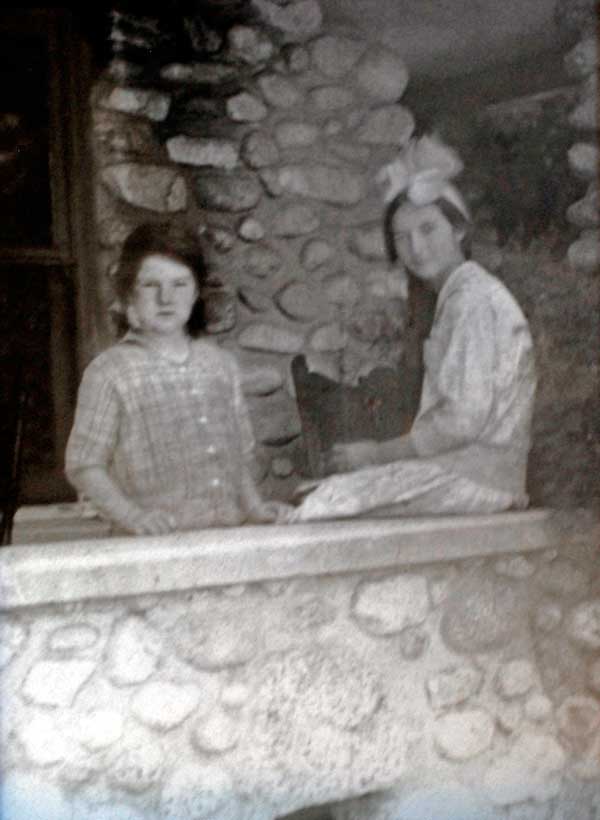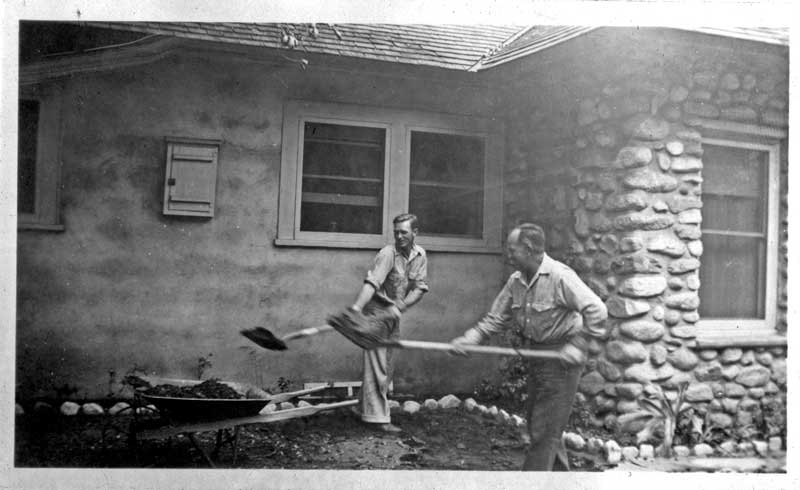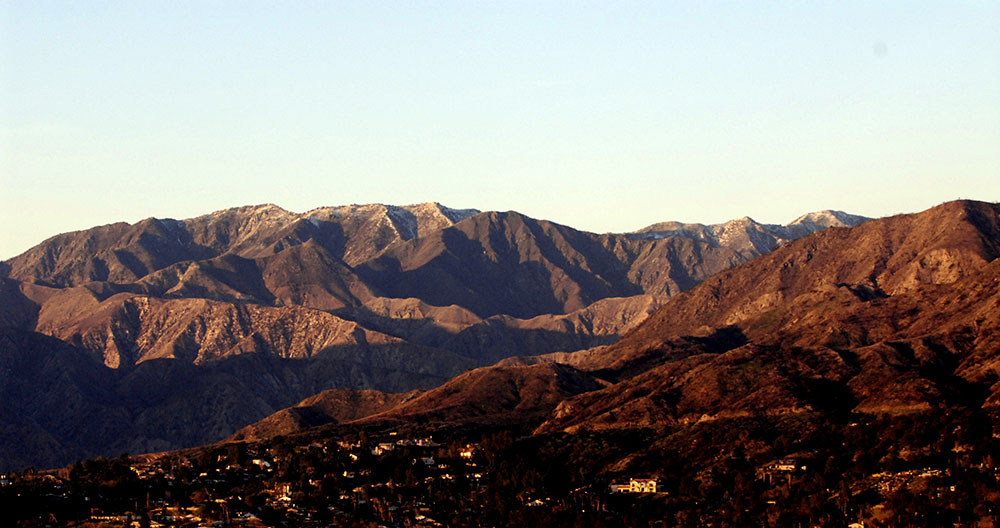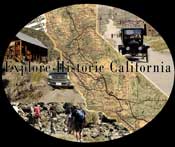|
For
nearly thirty years I have known of the historic Rowley House in my
neighborhood of Sunland/Tujunga. In the past ten years it finally
dawned on me that the magnificent rock house I regularly passed on
the backroads to the Sunland post office was the same one pictured
in my local history books. Somehow I missed the year it was offered
on our historic house tour. In the last year, I have been given a
personal glimpse into the past and present of this wonderful home,
thanks to newfound friendships. This is the second in a series about
the house and the hardy and often boisterous pioneers who called it
theirs in the early days of what was then known as Monte Vista
Valley.
This is
the third of three parts. Read
The Rowley's of Monte Vista Valley-Part I ,
The Rowley's of Monte Vista
Valley-Part II.
Virginia’s
Newcombe's father advised her before she headed up into the remote
Monte Vista Valley. As the former Civil War sergeant under General
Robert E. Lee, and the parent to a large family of all boys except
for Virginia, he knew exactly how to handle “upstarts” that had
closed down the one room school house tucked away in the foothills
between the green Verdugo Hills and the great San Gabriel Mountains.
If she had any hesitation to accept the teaching assignment that Dr.
Quinton Rowley had given her for his brother Loron’s community, it
was quelled by Sergeant Newcombe’s counsel, and her own experience
handling her many brothers.
 |
|
Undated
photo of Rowley girls on the front porch.
(Photo
courtesy Rowley House Collection) |
For two years,
Virginia taught in the little school house. Prominent Monte Vista
citizen, Loron Rowley, helped her become acquainted with the
schoolhouse and the remote neighborhood and eventually fell in love
with her. He was ten years older than she, but the age difference
didn’t seem to matter to either of them. After a two year courtship,
Loron and Virginia Florence Newcombe married in 1893. He took her to
his homesteaded ranch in the canyon now named after them, where the
modern community of Seven Hills (Tujunga), California, sits today.
The beautiful
canyon with the Rowley homestead was fortunate to have springs with
water except in the late summer, aiding Virginia with her home
garden and Loron with his crops. During rainy season, however, the
water would wash boulders down the canyon making for adventurous
living. It was also abundant with wildlife, particularly the coyotes
that howled all night and raided Virginia’s chicken coops.
From their
vantage point, the Rowley’s also had a view of the other ranches and
homesteads as they sprouted in the Monte Vista Valley. The Rowley
family lived here until brother Quinton took over the rundown Monte
Vista Hotel and asked them to manage it for him. They never let go
of the ranch, and returned to it when the hotel was sold to someone
else.
By 1905 Loron
was buying land in the valley closer to town where school and
services were nearby. Rock was the most abundant native building
material, so he took advantage of this and built the first rock home
in the area. Behind the magnificent little house, the backyard
proved perfect for Virginia’s garden, and the chickens were brought
down from the ranch and kept in a coop there.
The ever
present coyotes still taunted the chickens, and the Rowley boys,
Eustace and Robert, learned early on to grab their guns and scare
them off in the middle of the night. The large property also
included a spring, so running water was never a problem. Nearby
grass was always green from the constant dampness, allowing the
family to keep horses and milking cows, as well. The children
learned to milk the cows as soon as they were old enough to carry a
bucket.
 |
| The
fireplace mantle still retains a rustic look in the
Rowley House today. |
The rock house
was complete with a kitchen stove and two fireplaces, downstairs.
Upstairs, however, there was no heat. The children each had a rock
with their name scrawled on it, which was warmed in one of the
fireplaces, wrapped in old newspapers and put in their beds to keep
their feet warm. The family cat, Smuggle, chose to sleep in the
fireplace to keep warm, and often was seen walking around with
slightly singed fur.
Loron and
Virginia were well educated people, and took time to make sure their
children were as well. Although there wasn’t the time to read as he
would have liked to, Loron often quoted from Homer’s Illiad
and recited Robert Burns' poetry complete with Scottish dialect. His
own education had been interrupted during his senior year at the
University of Minnesota when the depression hit sending him in
search of a more prosperous life in California.
Virginia
focused on the children’s education, supplementing the three R’s and
geography and spelling that the one-room school house provided.
Rainy seasons caused the river to swell and wipe the road out to the
school so often, that the Rowley’s spearheaded efforts for a new
school closer to the center of town in the park. The county wouldn’t
provide the money for the school, unless there were six children.
The year attendance dropped to five, Virginia decided her second son
was old enough to attend at age four and a half, resolving the
problem.
Medical
services were lean in Monte Vista Valley. Births were attended by
midwives and often delivered by them if the doctor didn’t arrive in
time. There wasn’t even a formal method of recording births. In the
case of a serious accident, medical assistance was sought elsewhere.
Young Dorothy Rowley was riding Jenny Wornum’s horse one day and
broke her arm. Loron and Virginia raced her to town the four and a
half miles in the rain to the train depot at Roscoe. Here they
waited for the next train to Burbank where the doctor was.
Without the
modern medicines we have today, even commonplace ailments could be
deadly. At age fourteen, the youngest Rowley, Clara Virginia, died
from an ear infection. Virginia was schooled in home remedies, as
was common in the day. Her “Senna tea” was a popular cure not only
for her family, but for sick neighbors. The tea was served
internally as a purge, or externally, soaked in water with
turpentine, as an antibiotic.
Virginia was
also noted for her meals. After deer hunting trips in the canyons,
Virginia would cover the meat with wet gunny sacks to keep it fresh
until it could be cooked. Sunday’s were big dinners with chicken and
dumplings. The backyard garden provided the string beans, carrots,
and other vegetables she needed, and homemade biscuits and cornbread
completed the meal. The Rowley’s peach orchards provided fresh or
preserved fruit for desert. Traditionally, this hearty meal was
served mid-day. Biscuits and peaches with a mixture of honey and
butter were served later in the day as a light supper. Virginia’s
daughter tried to duplicate her mother’s dumplings in later years,
but never quite achieved the perfection she did.
Music played a
big part in the Rowley family life. Often they would be seen on the
big front porch of the rock house practicing their musical
instruments. Lessons were obtained from the local virtuoso, Walter
Maygrove. In addition to family entertainment, Virginia, Loron, and
oldest son Eustace would play at the Saturday night dances when
Bolton Hall opened up in Tujunga. Folk dances, Virginia reels,
waltzes, and two steps were popular.
Maintaining
the rock house in town and the ranch was a chore. As more families
moved into the valley there was fear that the homestead would be
quick claimed by someone else. Virginia and her youngest daughters
Marion and Clara Virginia often stayed at the ranch. Without modern
means of communications that we have today, they would arrange an
hour to signal by lantern to the family below that they were ok.
 |
|
"Red and
Eustace building patio in Sunland, 1939," reads the back
of this photo.
(Photo
courtesy Rowley House Collection) |
As the boys
got older they had to ride the buggy on the mail run on Roscoe
Station, and catch the train to school in Burbank. When school was
over they walked the five miles to get home. By Robert’s second year
of high school they were given a horse and buggy to drive ten miles
to school in San Fernando. Virginia didn’t allow her daughters to
attempt the difficult trek to the high school.
By 1918, the
Rowley family moved to Glendale so the girls could attend Glendale
High School. A family cousin bought the general store and Loron
became truant officer for the Glendale School District. Slowly the
land in Monte Vista Valley was sold off.
The Rowley
House remains standing today as a testament to the life they lived.
Their names are immortalized by canyons and streets named after them
in the Sunland-Tujunga communities and San Gabriel Mountains.
 |
|
Panoramic view of present day Vale of Monte Vista
(Sunland-Tujunga) looking north toward Big Tujunga
Canyon in the San Gabriel Mountains.
|
Bibliography
From Crackers to Coal Oil
by Mary Lee Tiernan
The Early History of
Sunland, California, Voume IV
Snoops Desktop Publishing
Sunland, California 91040
Founding sisters - Life Stories of Tujunga’s Early Women Pioneers
1886-1926
by Mary Lou Pozzo
Zinnia Press
Tujunga, California 2005
Rancho Tujunga
A History of Sunland/Tujunga, California
Compiled by Sarah R.
Lombard
Published by Sunland
Woman’s Club
Produced by Bridge
Publishing
Burbank, California
Sunland and Tujunga From Village To City
by Marlene A. Hitt
Little Landers Historical
Society
Arcadia Press, 2002
Special thanks to the
current residents of the Rowley House for graciously sharing their
personal archives with us.
|
